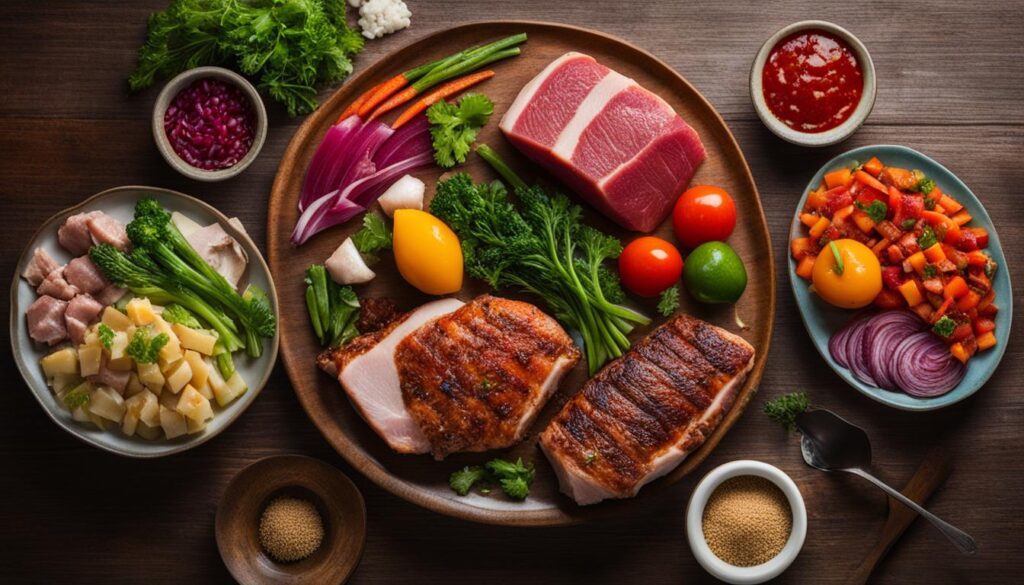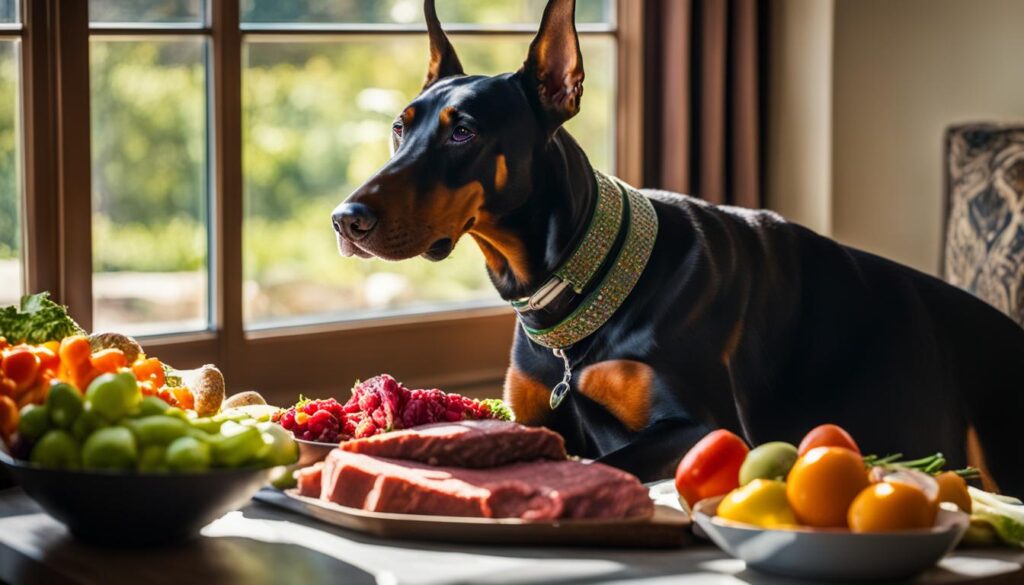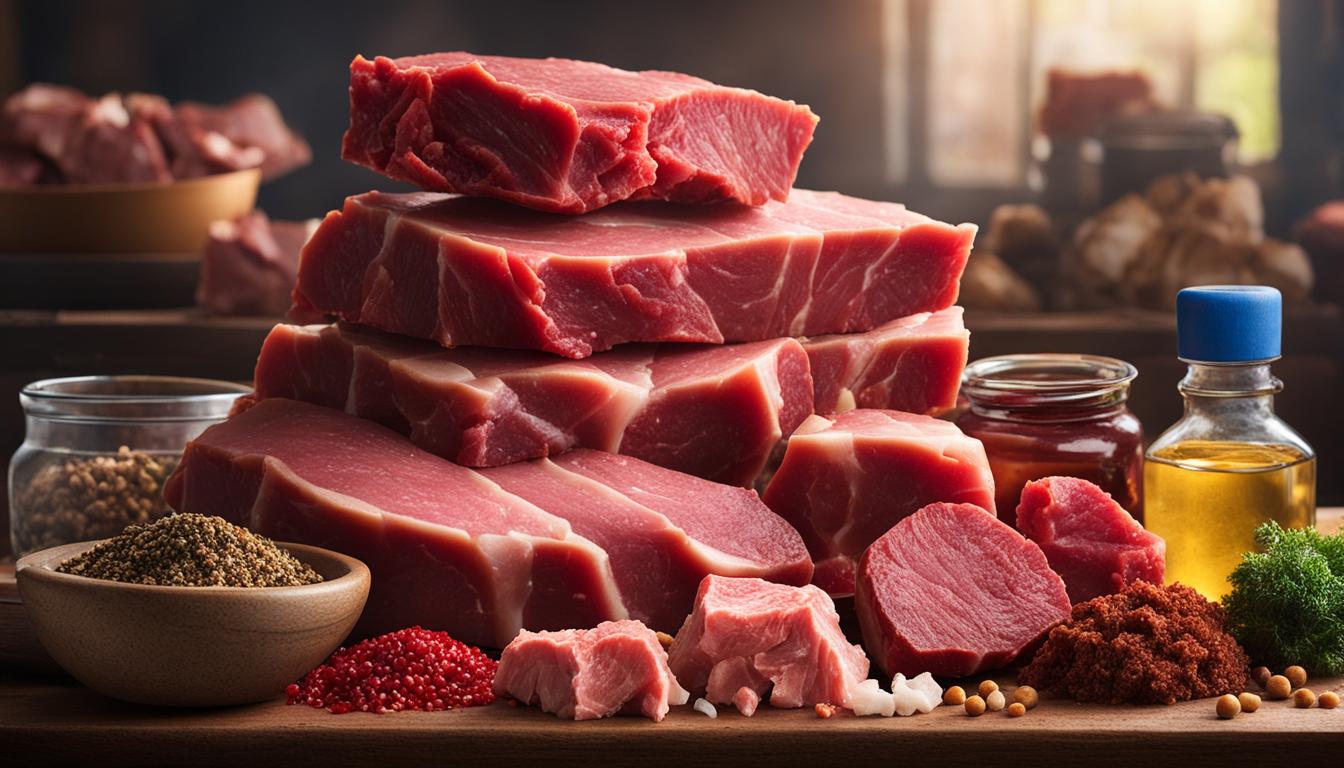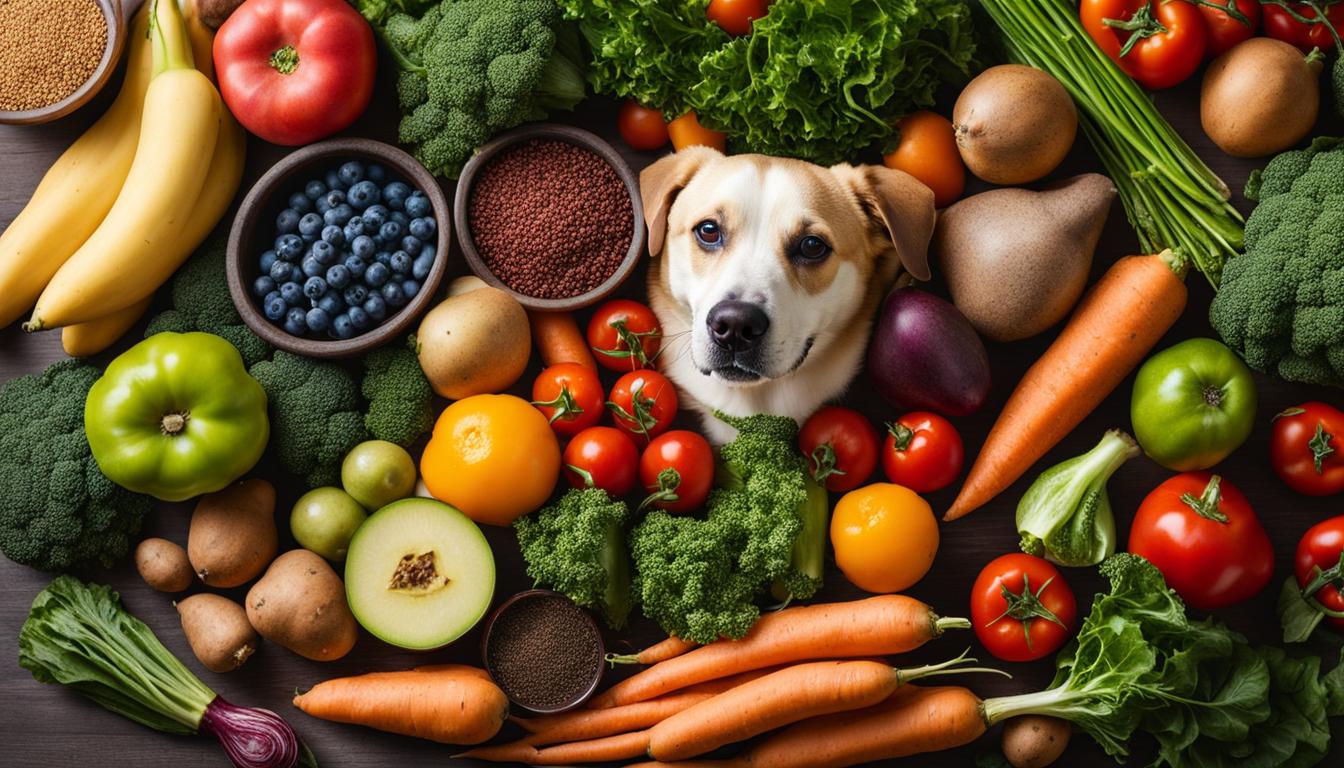Are you considering feeding your dog a raw meat diet? Raw dog food diets, which include raw meat, bones, fruits, and vegetables, have been gaining popularity among pet owners. Advocates of these diets claim that they can lead to shinier coats, healthier skin, cleaner teeth, higher energy levels, and smaller stools for dogs. However, it is important to be aware of the potential risks associated with raw diets.
Raw meat diets may offer benefits such as improved coat appearance and dental health, but they also pose certain risks. Bacterial contamination in raw meat can be a threat to both human and dog health. Moreover, if not carefully balanced, a raw diet may lack essential nutrients and damage a dog’s health in the long run. Additionally, there is a risk of bones causing choking or internal injuries in dogs.
Before transitioning your dog to a raw meat diet, it is crucial to consider these factors and consult with a veterinarian. They can help assess if this type of diet is suitable for your dog and provide guidance on ensuring a balanced and safe transition. Regular monitoring and nutritional analysis are essential to maintain your dog’s health and well-being on a raw meat diet.
Key Takeaways:
- Raw meat diets for dogs are becoming increasingly popular among pet owners.
- Advocates claim that these diets can lead to shinier coats, healthier skin, cleaner teeth, higher energy levels, and smaller stools.
- However, there are potential risks associated with raw diets, including bacterial contamination, an unbalanced diet, and the risk of bones causing choking or injuries.
- Consulting with a veterinarian and ensuring a balanced transition is crucial before switching your dog to a raw meat diet.
- Regular monitoring and nutritional analysis are important to maintain your dog’s health on a raw meat diet.
The Origins of Raw Dog Food Diets
The concept of feeding raw food diets to dogs was proposed by Australian veterinarian Ian Billinghurst in 1993. He introduced the BARF (Biologically Appropriate Raw Food) diet, suggesting that dogs should consume raw, meaty bones and vegetable scraps for optimal health. Billinghurst argued that grain-based commercial pet foods were detrimental to dogs’ well-being. However, this viewpoint is met with disagreement from mainstream veterinarians and the FDA, who emphasize the potential risks associated with raw diets.
According to Billinghurst, the BARF diet seeks to replicate what canines ate before they were domesticated. He believed that by feeding dogs a diet rich in raw meat and bones, pet owners could provide their dogs with a nutritionally balanced and biologically appropriate meal. This theory gained traction among dog owners who sought a more natural approach to their pets’ nutrition.
“The BARF diet aims to mimic the ancestral diet of dogs, which consisted of raw meat, bones, fruits, and vegetables. It emphasizes the importance of feeding dogs a diet that aligns with their biological needs.”
Despite the popularity of raw dog food diets, mainstream veterinarians and the FDA caution against their potential risks. They raise concerns about bacterial contamination in raw meat, which can pose health threats to both dogs and humans. In addition, an unbalanced diet lacking essential nutrients can lead to long-term health issues for dogs. Furthermore, the consumption of whole bones in a raw diet may result in choking or internal injuries. Therefore, it is crucial for dog owners to consider these risks and consult with a veterinarian before beginning a raw meat diet for their pets.

| Grain-based commercial pet foods | Biologically Appropriate Raw Food (BARF) Diet |
|---|---|
| Contain processed grains and fillers | Emphasizes raw meat, bones, fruits, and vegetables |
| Potential for allergic reactions and digestive issues | Advocates believe it leads to shinier coats, healthier skin, and higher energy levels |
| May contribute to dental problems and obesity | Supporters claim it can result in cleaner teeth and smaller stools |
| Meets basic nutritional requirements | Focuses on providing a nutritionally balanced and biologically appropriate diet |
Potential Benefits of Raw Dog Food Diets
Proponents of raw dog food diets believe that these diets can result in shinier coats, healthier skin, cleaner teeth, higher energy levels, and smaller stools for dogs. Many pet owners have reported positive changes in their dogs’ appearances and overall health after transitioning to a raw meat diet. While scientific evidence supporting these claims is limited, there are anecdotal accounts of the benefits of raw diets.
Switching to a raw meat diet can help promote shinier coats in dogs. The natural oils found in raw meat can improve coat texture and shine, leading to a healthier and more lustrous appearance. Additionally, raw diets often contain higher levels of essential fatty acids, which are crucial for maintaining healthy skin and preventing dryness or irritation.
Cleaner teeth are another potential benefit of raw dog food diets. Gnawing on raw meaty bones helps remove plaque and tartar buildup, reducing the risk of dental issues such as gum disease and tooth decay. The mechanical action of chewing on bones can also strengthen jaw muscles and prevent dental pain or discomfort in dogs.
Raw meat diets are often associated with higher energy levels in dogs. The natural, unprocessed ingredients provide optimal nutrition, leading to improved energy production and better overall vitality. Dogs on raw diets may experience increased stamina, enhanced performance in physical activities, and a greater sense of overall well-being.
Lastly, feeding dogs a raw meat diet can result in smaller stools. Raw diets are typically more digestible for dogs as they contain fewer fillers and additives found in processed pet foods. Smaller stools are not only more convenient for pet owners to clean up, but they can also indicate that a dog’s body is efficiently utilizing the nutrients in their diet.
While these potential benefits are compelling, it is essential to consider the potential risks and consult with a veterinarian before making any significant dietary changes for your dog.

Potential Risks of Raw Dog Food Diets
While raw dog food diets have gained popularity in recent years, it is important to be aware of the potential risks associated with these diets. Understanding these risks can help pet owners make informed decisions about their dog’s nutrition. In this section, we will explore the threats to human and dog health, the possibility of an unbalanced diet, and the choking hazards that may arise from feeding raw meat to dogs.
Threats to Human and Dog Health
One of the significant concerns with raw dog food diets is the risk of bacterial contamination. Raw meat can harbor bacteria such as salmonella and E. coli, which can pose a threat to both human and dog health. Handling raw meat exposes pet owners to these bacteria, increasing the risk of infection. Additionally, dogs can also become ill from consuming raw meat contaminated with bacteria.
It is crucial to practice proper food hygiene when handling raw meat for your dog’s diet. Thoroughly wash your hands, utensils, and surfaces that come into contact with raw meat to minimize the risk of bacterial contamination.
Unbalanced Diet
An unbalanced diet is another potential risk associated with raw dog food diets. While raw meat provides valuable nutrients, such as protein and essential fatty acids, it may lack other essential nutrients like carbohydrates and certain vitamins and minerals. A long-term unbalanced diet can lead to nutritional deficiencies and health problems in dogs. It is essential to ensure that any raw dog food diet is properly formulated to meet the dog’s nutritional needs.
Choking Hazards
The consumption of whole bones in a raw diet can present choking hazards for dogs. Bones can splinter and cause blockages or injuries to a dog’s internal organs. It is crucial to choose appropriate bone options and monitor the dog’s chewing behavior to prevent any choking incidents. If you choose to feed your dog a raw meat diet, consult with your veterinarian for guidance on safe bone choices and portion sizes to minimize the choking risks.
| Risks | Precautions |
|---|---|
| Bacterial contamination | Practice proper food hygiene, wash hands and surfaces thoroughly |
| Unbalanced diet | Ensure the diet is properly formulated to meet nutritional needs |
| Choking hazards | Choose appropriate bone options, monitor chewing behavior |
Different Types of Raw Dog Food Diets
Since the publication of Billinghurst’s book, “Give Your Dog a Bone,” several other types of raw dog food diets have emerged. Pet owners now have a variety of options to choose from when it comes to feeding their dogs a raw meat diet. Let’s take a closer look at some of the different types of raw dog food diets:
Commercially Processed Raw Food Diets
Commercially processed raw food diets are becoming increasingly popular among pet owners. These diets typically consist of frozen or freeze-dried raw meat, bones, fruits, and vegetables. The food is carefully formulated to provide balanced nutrition for dogs, ensuring they receive all the necessary nutrients in the right proportions. These pre-packaged raw food diets offer convenience and peace of mind, as they are prepared and ready to serve.
Combination Diets
Combination diets are another option for pet owners who want to incorporate raw food into their dogs’ diets. These diets consist of a mix of raw meat and other ingredients, such as grains, vegetables, and vitamins. Some pet owners choose to create their own blends, while others may purchase commercially available combination diets. These diets provide the flexibility to customize the food according to the specific needs and preferences of the dog.
Raw Dog Food Recipes
For those who prefer a DIY approach, raw dog food recipes offer the opportunity to prepare homemade raw meals for their furry friends. There are numerous recipes available online and in books that provide guidance on how to create balanced and nutritious raw food for dogs. These recipes often include a combination of raw meat, bones, fruits, vegetables, and supplements to ensure a complete and well-rounded diet.
| Type of Raw Dog Food Diet | Key Features |
|---|---|
| Commercially Processed Raw Food Diets | Frozen or freeze-dried raw meat, bones, fruits, and vegetables Convenient and pre-packaged for easy feeding |
| Combination Diets | Blend of raw meat, grains, vegetables, and vitamins Offers flexibility and customization |
| Raw Dog Food Recipes | Homemade meals using raw meat, bones, fruits, vegetables, and supplements Provides control and customization |
Safety Concerns with Raw Meat Diets
When considering a raw meat diet for your dog, it is important to be aware of the safety concerns associated with it. One of the main concerns is the risk of bacterial contamination. Raw meat can contain harmful bacteria, such as Salmonella and E. coli, which can pose a threat not only to your dog’s health but also to your own. To mitigate this risk, it is crucial to follow proper handling and hygiene practices when preparing and serving raw meat to your furry friend.
The U.S. Food and Drug Administration (FDA) has issued guidelines to help improve the safety of raw pet food. These guidelines emphasize the importance of sourcing high-quality ingredients, proper storage and handling, and implementing safety measures during manufacturing. However, it is essential to understand that commercially processed pet foods can also carry the risk of bacterial contamination, so it is crucial to exercise caution regardless of the type of food you choose for your dog.
When handling raw meat, remember to thoroughly wash your hands with soap and water before and after preparation. Use separate utensils and cutting boards for raw meat and other ingredients to prevent cross-contamination. It is recommended to clean and disinfect all surfaces that come into contact with raw meat to eliminate any potential bacteria. By following these precautions, you can help ensure the safety of both you and your furry companion.
“Proper handling and hygiene are key when it comes to feeding your dog a raw meat diet. By following guidelines and taking necessary precautions, you can minimize the risk of bacterial contamination and keep your pet healthy.”
Table: Tips for Handling Raw Meat Safely
| Tip | Description |
|---|---|
| 1 | Always wash your hands before and after handling raw meat. |
| 2 | Use separate utensils and cutting boards for raw meat and other ingredients. |
| 3 | Clean and disinfect all surfaces that come into contact with raw meat. |
| 4 | Ensure proper storage of raw meat to prevent bacterial growth. |
| 5 | Follow FDA guidelines for sourcing high-quality ingredients and manufacturing processes. |
Considerations for Transitioning to a Raw Meat Diet
If you’re considering transitioning your dog to a raw meat diet, there are a few important considerations to keep in mind. These factors can help ensure a smooth transition and the optimal health of your furry friend.
Transition Process
The transition process from a traditional dog food diet to a raw meat diet should be done gradually. Start by introducing small amounts of raw meat alongside your dog’s regular food, gradually increasing the proportion of raw meat over time. This allows your dog’s digestive system to adjust and helps prevent any sudden gastrointestinal upsets.
Table: Example Transition Plan
| Days | Traditional Dog Food | Raw Meat Diet |
|---|---|---|
| 1-3 | 75% | 25% |
| 4-7 | 50% | 50% |
| 8-14 | 25% | 75% |
| 15+ | 0% | 100% |
Dogs with Specific Health Conditions
It’s important to consult with your veterinarian before transitioning dogs with specific health conditions to a raw meat diet. Dogs with pancreatitis or digestive issues may require a more gradual transition, starting with a cooked, homemade diet before introducing raw meat. Dogs with cancer, undergoing chemotherapy, or have weakened immune systems should not be fed a raw food diet, as their immune systems may not be able to handle any potential bacteria in raw meat.
Puppies
Puppies have unique nutritional needs, and it’s crucial to ensure their diet provides the right balance of nutrients. When introducing a raw meat diet to a puppy, it’s important to consult with your veterinarian to ensure the appropriate calcium and phosphorus ratio. An improper ratio can lead to bone deformities and growth issues.
Transitioning your dog to a raw meat diet can have potential benefits, but it’s essential to proceed with caution and consider these factors for the health and well-being of your furry companion.
Conclusion
So, you’ve weighed the pros and cons of raw meat diets for dogs and now it’s time to make a decision. Raw meat diets can offer benefits like shinier coats, cleaner teeth, and higher energy levels for your furry friend. However, it’s important to be aware of the potential risks, such as bacterial contamination and unbalanced nutrition.
Before diving into a raw meat diet, consult with your veterinarian to ensure it’s the right choice for your dog. They can provide you with a nutritional analysis tailored to your dog’s specific needs. Regular monitoring and adjustments may be necessary to maintain your dog’s optimal health and well-being on a raw meat diet.
Remember, not all dogs are suitable candidates for raw meat diets. Dogs with certain health conditions or weakened immune systems may not benefit from or tolerate this type of diet. It’s always better to be safe than sorry, so seek professional advice and guidance.
In the end, the choice is yours. Raw meat diets can be a viable option for dog owners who are willing to put in the time and effort to ensure their pet’s nutrition and safety. With the right precautions, a raw meat diet can provide your dog with a wholesome and balanced meal.
FAQ
Are raw meat diets beneficial for dogs?
Raw meat diets have been associated with shinier coats, healthier skin, cleaner teeth, higher energy levels, and smaller stools in dogs. However, the scientific evidence supporting these claims is limited.
What are the potential risks of raw meat diets for dogs?
Raw meat diets carry the risk of bacterial contamination, which can pose threats to both human and dog health. Additionally, an unbalanced diet lacking essential nutrients can harm a dog’s health if given for an extended period. The consumption of whole bones in a raw diet can also lead to choking and internal injuries in dogs.
What are the different types of raw dog food diets?
There are commercially processed raw food diets, which are frozen or freeze-dried, as well as combination diets that use blends of grains, vegetables, and vitamins mixed with raw meat purchased by the owner. Raw dog food recipes and meal suggestions can also be found online and in books, allowing pet owners to prepare homemade raw meat dog food.
How can bacterial contamination be prevented when feeding raw meat diets to dogs?
It is important to handle raw meat with caution, including thorough handwashing and disinfection of surfaces. The FDA has issued guidelines to improve the safety of raw pet food, as studies have found higher levels of disease-causing bacteria in raw pet food compared to other types of pet food.
What should be considered when transitioning a dog to a raw meat diet?
Dogs with specific health conditions, such as pancreatitis or digestive issues, may require a gradual transition with a cooked, homemade diet before switching to raw. Dogs with cancer, undergoing chemotherapy, or those with weakened immune systems should not consume raw food. Additionally, puppies have specific nutritional needs, and an incorrect calcium and phosphorous ratio in raw diets can lead to bone deformities and growth issues.
Should I feed my dog a raw meat diet?
The decision to feed your dog a raw meat diet should be carefully weighed, considering the potential benefits and risks. Consulting with a veterinarian and regularly conducting nutritional analysis and monitoring are vital to ensure the proper health and well-being of dogs on raw meat diets.





